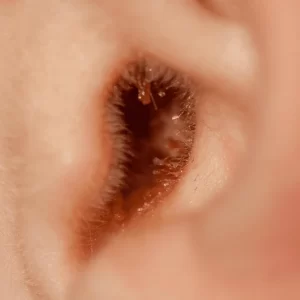Is My Ear Infection Contagious?
- Updated on: Feb 29, 2024
- 6 min Read
- Published on Jun 6, 2023

Ear infections are a common health condition that can affect people of all ages. An ear infection, also known as otitis media, occurs when the middle ear becomes infected and inflamed. This condition can cause a variety of symptoms, including ear pain, drainage from the ear, and hearing loss.
Understanding the contagiousness of ear infections is crucial for preventing the spread of this condition. Ear infections can be caused by bacterial, viral, or fungal infections, and can spread easily from person to person. This is especially true for young children, who are more susceptible to developing ear infections and are more likely to transmit the infection to others. Ear infections can occur due to nasal problems such as sinusitis as well.
By understanding how ear infections spread, individuals can take steps to prevent the spread of this condition. This includes good hygiene practices, such as washing hands frequently, avoiding sharing personal items like earbuds, and covering the mouth and nose when coughing or sneezing.
Causes of Ear Infections
Ear infections can be caused by a variety of factors. The most common causes of ear infections are bacterial, viral, or fungal infections.
Other potential causes of ear infections include:
- Allergies: Allergies can cause inflammation in the sinuses, which can lead to fluid buildup in the ears and an increased risk of ear infections.
- Blocked Eustachian tubes: The Eustachian tubes connect the middle ear to the back of the throat, and they can become blocked due to allergies, sinus infections, or other factors. When the Eustachian tubes are blocked, fluid can accumulate in the middle ear, increasing the risk of infection.
- Changes in altitude: Changes in altitude, such as during air travel or driving in the mountains, can cause changes in pressure in the middle ear, leading to pain and an increased risk of infection.
- Water exposure: Water exposure can increase the risk of bacterial or fungal infections in the ear canal, leading to external ear infections.

Symptoms of Ear Infections
The symptoms of ear infections can vary depending on the location and severity of the infection. However, some of the most common symptoms include:
- Pain in the ear: This is often the first symptom of an ear infection. The pain may be sharp, dull, or throbbing and can range from mild to severe.
- Drainage from the ear: Ear infections can cause fluid to build up in the middle ear, leading to drainage from the ear. The fluid may be clear, cloudy, or bloody.
- Hearing loss: Ear infections can affect the ability to hear, especially in children. Temporary hearing loss may occur due to the buildup of fluid in the middle ear.
- Fever: A fever is a common symptom of ear infections, especially in children.
- Dizziness and balance problems: Inner ear infections can cause dizziness, vertigo, and balance problems.
- Nausea and vomiting: Inner ear infections can cause nausea and vomiting.
- Difficulty sleeping: Ear infections can cause discomfort and pain, making it difficult to sleep.
Ear Infections in Children
Ear infections, specifically known as “acute otitis media,” are prevalent among children, marking one of the primary reasons for pediatric medical consultations. These infections manifest within the middle ear, a space situated right behind the eardrum, usually following a cold or respiratory infection. Viruses or bacteria can enter this area, causing an accumulation of fluid, leading to symptoms that parents can easily notice, such as pain, fever, irritability, or even reduced hearing. Though the ear infection itself isn’t contagious, the colds and viruses that precipitate it can easily spread among children. Several preventive strategies, including good hygiene practices, proper handwashing, avoiding exposure to secondhand smoke, and ensuring infants aren’t bottle-feeding while lying flat, can mitigate the risk. However, if an infection is suspected, prompt medical attention is essential. Not only will a health professional offer the right treatment, but they can also provide guidance on care and symptom relief.
Contagiousness of Ear Infections
Ear infections are typically caused by viruses or bacteria and can spread from person to person through close contact. The bacteria or viruses can be transmitted through respiratory droplets when an infected person coughs, sneezes or talks. They can also be spread by sharing items like utensils, towels, or phones.
Certain factors can increase the risk of spreading ear infections, such as:
- Age: Children are more likely to get ear infections and also more likely to spread them due to close contact in school or daycare settings.
- Weakened immune system: People with weakened immune systems are more susceptible to infections and can spread them more easily.
- Exposure to secondhand smoke: Exposure to secondhand smoke can increase the risk of developing ear infections and make them more contagious.
- Environmental factors: Exposure to pollution, allergens, and other environmental factors can weaken the immune system and increase the risk of infection.
The contagious period for an ear infection depends on the cause. Viral infections are usually contagious for about 7-10 days, while bacterial infections can be contagious for as long as the bacteria are present in the body. In some cases, the contagious period can extend beyond the resolution of symptoms, making it important to take precautions to prevent spreading the infection even after symptoms have subsided.
Prevention of Ear Infections
Ear infections can be prevented through good hygiene practices, vaccinations, and avoiding exposure to secondhand smoke.
Here’s a closer look at each of these prevention methods:
A. Good hygiene practices:
- Wash hands frequently with soap and water, especially after being around someone who is sick.
- Avoid sharing personal items such as towels and earbuds.
- Clean and disinfect surfaces that may be contaminated with bacteria or viruses.
- Cover your mouth and nose when you cough or sneeze.
B. Vaccinations:
- The pneumococcal vaccine can prevent certain types of bacteria that cause ear infections.
- The flu vaccine can help prevent influenza, which can lead to ear infections.
- The Hib vaccine can protect against Haemophilus influenzae, a bacterium that can cause ear infections.
C. Avoiding exposure to secondhand smoke:
- Secondhand smoke can increase the risk of ear infections in children and adults.
- If you smoke, quit smoking to reduce the risk of ear infections for yourself and those around you.
- Avoid exposing children to secondhand smoke, as they are more susceptible to ear infections.
It’s important to note that while these prevention methods can reduce the risk of ear infections, they may not guarantee complete protection. It’s also important to practice good ear hygiene, such as avoiding the use of cotton swabs in the ear canal and drying the ears thoroughly after swimming or showering.
Treatment of Ear Infections
When it comes to treating ear infections, there are several options available depending on the type and severity of the infection. Treatment options may vary between individuals and should be determined by a medical professional.
Here are the most common treatment methods:
- Antibiotics: Ear infections caused by bacteria are typically treated with antibiotics. These medications are usually prescribed for a course of 7 to 10 days, and it’s important to finish the full course even if symptoms improve sooner. Antibiotics can be administered orally, through ear drops or intravenously for more severe infections.
- Pain relief medication: Pain is one of the most common symptoms of ear infections, and it can be quite severe. Over-the-counter pain medication such as ibuprofen or acetaminophen can be used to alleviate discomfort. Additionally, warm compresses or heating pads can be placed on the ear to help reduce pain.
- Surgical interventions: In some cases, surgery may be required to treat an ear infection. This is typically reserved for chronic infections that don’t respond to other treatments. The most common surgical procedures for ear infections are myringotomy, which involves making a small incision in the eardrum to drain fluid, and tympanoplasty, which repairs a perforated eardrum.
It’s important to note that not all ear infections require antibiotics. Viral infections, for example, do not respond to antibiotics, and in some cases, antibiotics may even be harmful. In these cases, treatment typically focuses on managing symptoms and allowing the body to fight off the infection on its own.
When to Seek Medical Attention
Untreated ear infections can lead to severe complications that can impact hearing and overall health. It is important to know when to seek medical attention if you suspect that you have an ear infection.
A. Complications of Untreated Ear Infections:
- Hearing Loss: Untreated ear infections can cause temporary or permanent hearing loss due to damage to the structures of the ear.
- Spread of Infection: If the infection is left untreated, it can spread beyond the ear to nearby structures, including the brain and spinal cord.
- Ruptured Eardrum: Severe ear infections can cause the eardrum to burst, leading to pain, bleeding, and increased risk of infection.
- Balance Issues: Ear infections can affect the balance organs in the ear, leading to vertigo and dizziness.
B. When to See a Doctor for an Ear Infection:
- Persistent Symptoms: If you experience symptoms of an ear infection for more than a day or two, it is important to see a doctor for an evaluation.
- Pain and Discomfort: If the pain is severe or accompanied by discharge, swelling, or fever, it is important to seek medical attention.
- Hearing Loss: If you experience a sudden or significant loss of hearing, it is important to see a doctor immediately.
- Recurrent Infections: If you have frequent or recurring ear infections, it is important to see a doctor to determine the underlying cause and prevent further complications.












